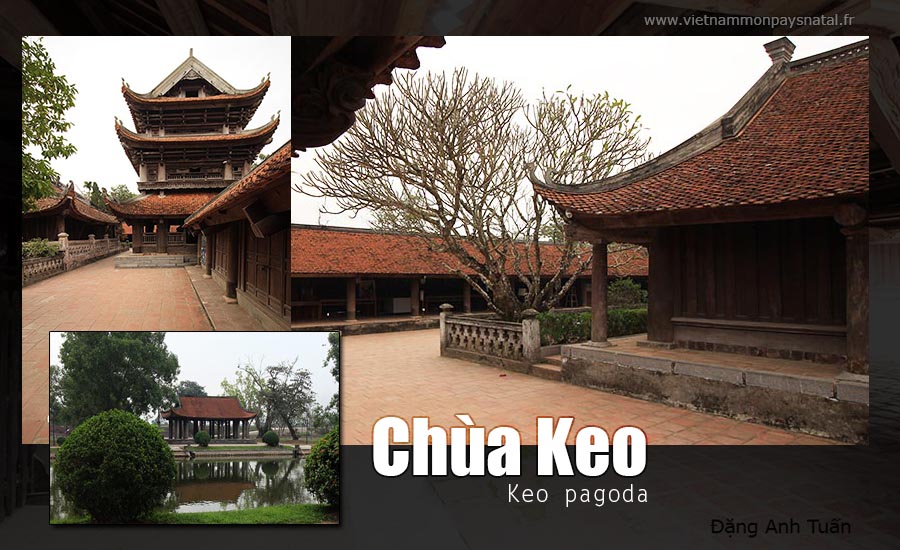En évoquant Thái Bình, on ne cesse pas de penser à sa spécialité locale (soupe de poissons) et à sa pagode Keo. Etant préparé minutieusement avec les morceaux de carpe d’eau douce assaisonnés avec de la poudre de curcuma,, ce plat associé aux nouilles de riz crée à la fois un goût délicieux et aromatique avec les feuilles d’aneth et de basilic, ce qui lui permet de rivaliser incontestablement avec le phở, le bouillon des Tonkinois.
Quant à la pagode Keo, elle est véritablement un ancien ouvrage architectural localisé dans le district Vũ Thư avec une superficie de 40.907,9m2. Etant considérée souvent comme une chef d’œuvre d’art basé essentiellement sur l’utilisation des étais du bois de fer précieux (gỗ lim), cette pagode possède plus de 100 travées de taille diverse et un clocher magnifique à 3 étages dont chacun possède son propre toit aux tuiles « mủi hài » et une cloche en bronze carrelé. On ne conteste pas sa réputation d’être le plus beau joyau architectural typique datant de l’époque des Lê postérieurs. Son dôme ressemble à une fleur de lotus épanouie au milieu de la cour de la pagode. L’organisation du culte religieux est la particularité de cet édifice avec Tiền Phật hậu Thần Thánh ( Bouddha dans la cour avant et les Génies dans la cour arrière). C’est pourquoi on retrouve prioritairement Bouddha dans la salle antérieure (tiền đường) de la pagode tandis qu’on pratique le culte des génies, en particulier celui du moine Dương Không Lộ dans la salle postérieure (hậu đường). Etant issus des écoles religieuses Vô Ngôn Thông et Thảo Đường, Dương Không Lộ était non seulement le Maître du Royaume sous la dynastie des Lý mais aussi l’inventeur de la fonderie vietnamienne. Cette pagode est habituée à organiser chaque année le festival des rites traditionnels ayant lieu au printemps (le 4e jour du 1er mois lunaire), et à l’automne (entre le 13ème et le 15ème jour du 9e mois lunaire). La fête est tellement importante que les filles ne peuvent pas s’en passer avec le dicton suivant:
Dù cho cha đánh mẹ treo, Em không bỏ hội chùa Keo hôm rằm.
Malgré l’interdiction de mes parents,
je ne peux pas laisser tomber le festival des rites traditionnels au jour du mois lunaire.
Un joyau architectural vietnamien
Galerie des photos
In speaking of Thái Bình province, one does not cease thinking about its local speciality (fish soup) and Keo pagoda. Being carefully prepared with seasoned pieces of freshwater carp in turmeric powder, this meal combined with noddles gives simustaneously a delicious and aromatic taste by the presence of dill and basil leaves, which allow it to compete with phở, the Tonkinese soup. For the Keo pagoda, there is an older architectural artefact located in the Vũ Thư district and covering a land area of 40.907,9m2. Being considered as a greatest masterpiece of art and based essentially on the use of precious wooden struts (gỗ lim), this pagoda has more than 100 various-sized spans and a magnificient three–level bell tower, each of which posseses its own roof with shaped tiles (mũi hài) and a bell in tiled bronze. One does not deny its reputation for being the most beautiful architectural jewel dating from the time of Later Lê Dynasty. Its dome looks like a flower blossomed in the midst of pagoda’s yart. The organization of religious worship is the particularity of this building with Tiền Phật hậu thần thánh (Buddha in front yard and geniuses in rear yard). That is why Buddha is fund in the anterior room (tiền đường) while the cult of geniuses, in particular that of Dương Không Lộ monk takes place in the posterior room (hậu đường). Coming from religious schools Vô Ngôn Thông and Thảo Đường, Dương Không Lộ was not only the great master of the kingdom under Ly dynasty but also the inventor of Vietnamese foundry. This pagoda is accustomed to organize each year the religious festival in the spring (4th day of the first lunar month) and autumn (between 13th and 15th day of the 9th lunar month). The festival is so important that girls cannot do without it with the following saying:
Dù cho cha đánh mẹ treo, em không bỏ hội chùa Keo hôm rằm.
Despite the interdiction of my parents, I cannot renounce the Keo festival at the lunar day.
Chùa Keo một kiến trúc đẹp nhất ở Vietnam
Nhắc đến Thái Bình thì không thể quên được món canh cá rô và chùa Keo. Canh cá, món nầy được kết hợp với bánh đa, tạo ra một hương vị đầm đà với lá thì là, húng bạc hà, không thua chi món phở của người miền Bắc còn chùa Keo thì là một công trình kiến trúc cổ độc đáo nằm trong huyện Vũ Thư và có diện tích 40.907,9m2. Đựơc xem là một kiệt tác nghệ thuật bằng gỗ lim , có hơn một trăm gian lớn nhỏ khác nhau và nhất là có một gác chuông gồm có ba tầng, 12 mái, khung gỗ, mái lợp ngói mũi hài. Gác chuông là một kiến trúc tiêu biểu dưới thời Hậu Lê và được xem là đẹp nhất của vùng Bắc Bộ với hình dáng của một hoa sen vương lên giữa sân chùa. Chùa Keo có đặc điểm riêng trong việc thờ tự, ngoài thờ Phật phía sau còn thờ thánh.(tiền Phật, hậu Thánh). Vì vậy phía sau là nơi thờ thiền sư Dương Không Lộ, đựợc phong làm thánh. Ông thuộc phái Vô Ngôn Thông và phái Thảo Đường, làm Quốc sư dưới triều nhà Lý và được xem là vị tổ của nghề đúc đồng. Chùa nầy hằng năm còn có tổ chức những ngày lễ hội truyền thống dành cho mùa Xuân và mùa Thu. Ngày lễ hội quan trọng cho đến đổi có câu ca dao về hội chùa Keo:
Dù cho cha đánh mẹ treo,
Em không bỏ hội chùa Keo hôm rằm.

